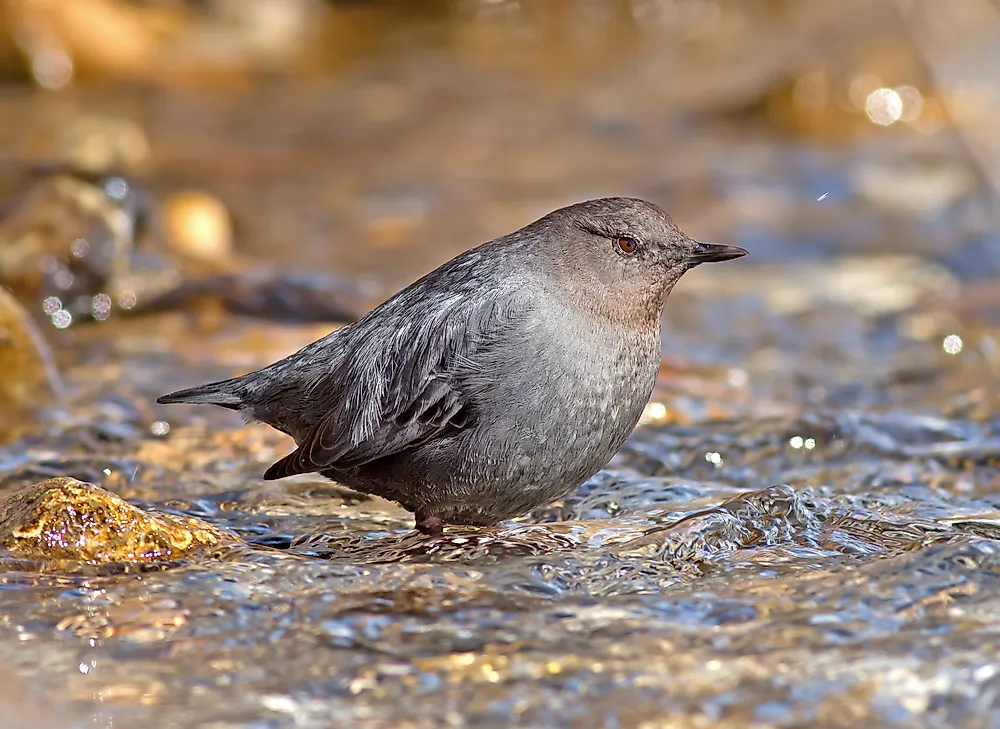Water Ouzel Facts: Animals of North America

5. Physical Description
Thought to be one of naturalist John Muir’s favorite birds of all times, the Water Ouzel, also known as the American Dipper, is a minute bird typically found in the high mountains of North and Central America. These accomplished avian divers are dark gray or brown in color, with distinctive white feathers found on their eyelids. They are able to hunt for food underwater by ducking, thanks to their nictitating membrane and flaps that keep water from entering their nostrils while they pluck their food from rushing streams. Their dense feathers are also characteristic, in that they are kept waterproof by a secretion of special preening oils that are only to be found in dipper plumages.
4. Diet
The American dipper feeds on small aquatic insects such as springtails, water bugs, lacewings, and fish flies. Caddis flies, beetles, damselflies, and scorpion flies are particular favorites as well, along with tadpoles, dragon flies and small crayfishes. Dippers are efficient divers, and they are able to withstand extremely cold water temperatures due to their thick feathers and relatively slow metabolisms. They like foraging for midges, larvae, and countless fish eggs in unpolluted mountain streams and lakes, where they wade, duck, and dive in search of food.
3. Habitat and Range
American dippers are rarely found living too far away from fast moving and pebbly mountain streams and lakes. Within these they find majority of their food sources, and they build their nests nearby, high up off of the ground and away from predators. They are considered North America’s only real song bird and, fortunately, are populous enough to be classified as animals of "Least Concern" by the IUCN due to their large numbers and vast diaspora. Nonetheless, destructive human activities such as deforestation, unsustainable agricultural practices, air and water pollution, and sudden climate changes, which affect the water temperature of areas where they hunt for food, have greatly reduced the population of the American Dippers.
2. Behavior
Water Ouzels are called dippers because of the distinctive dipping or ducking movements that they make when catching their prey. They are mostly solitary, and are able to effectively defend their nests as well as withstand low temperatures within their natural habitats. Instead of using webbed feet, they use their wings to make swimming motions underwater, propelling themselves to submerged areas where an abundance of their food sources can be found. Water ouzels are easily identified by their loud songs, which can be clearly heard above the noise that the rushing waters of their habitats make. To the famous naturalist and intellectual John Muir, the songs of the Water Ouzels were cheery and a delight, making them seem indomitable and more joyous than most other birds.
1. Reproduction
The majority of the American dipper population only mates with one partner, although some dippers will at times mate with multiple birds within a single breeding season. Nest sites seem to be the deciding factor for females when choosing which male to breed with, especially if more than one is located within their territory. The building of the nests are carried out by both individual breeding partners, although it is the female that chooses the location. It is also the female that is responsible for incubating the four to five eggs that she lays. Meanwhile, the males look for food and take them back to their families. The young are expected to remain in the nest for no more than 26 days, after which time they will have learned how to sufficiently swim and dive and search for food of their own.











